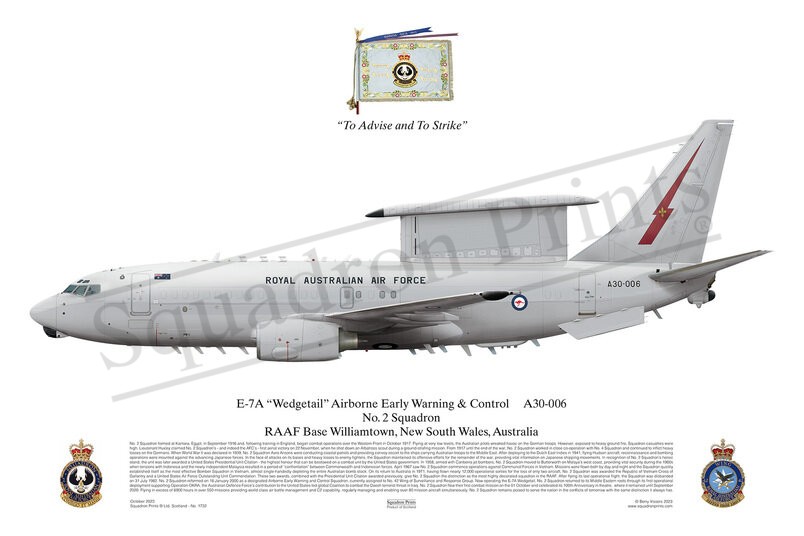#1732 2 Sqn E-7A Wedgetail print

Description
Squadron Prints Lithograph No 1732 - A30-006, E-7A Wedgetail, 2 Squadron, RAAF Base Williamtown.
No. 2 Squadron formed at Kantara, Egypt, in September 1916 and, following training in England, began combat operations over the Western Front in October 1917. Flying at very low levels, the Australian pilots wreaked havoc on the German troops. However, exposed to heavy ground fire, Squadron casualties were high. Lieutenant Huxley claimed No. 2 Squadron’s - and indeed the AFC’s - first aerial victory on 22 November, when he shot down an Albatross scout during a ground-strafing mission. From 1917 until the end of the war, No. 2 Squadron worked in close co-operation with No. 4 Squadron and continued to inflict heavy losses on the Germans. When World War II was declared in 1939, No. 2 Squadron Avro Ansons were conducting coastal patrols and providing convoy escort to the ships carrying Australian troops to the Middle East. After deploying to the Dutch East Indies in 1941, flying Hudson aircraft, reconnaissance and bombing operations were mounted against the advancing Japanese forces. In the face of attacks on its bases and heavy losses to enemy fighters, the Squadron maintained its offensive efforts for the remainder of the war, providing vital information on Japanese shipping movements. In recognition of No. 2 Squadron’s heroic stand, the unit was later awarded a United States Presidential Unit Citation - the highest honour that can be bestowed on a combat unit by the United States government. In 1958, armed with Canberra jet bombers, No. 2 Squadron moved to Butterworth on Malaya’s west coast, providing vital security during the 1960s when tensions with Indonesia and the newly independent Malaysia resulted in a period of “confrontation” between Commonwealth and Indonesian forces. April 1967 saw No. 2 Squadron commence operations against Communist Forces in Vietnam. Missions were flown both by day and night and the Squadron quickly established itself as the most effective Bomber Squadron in Vietnam, almost single-handedly depleting the entire Australian bomb stock. On its return to Australia in 1971, having flown nearly 12,000 operational sorties for the loss of only two aircraft, No. 2 Squadron was awarded the Republic of Vietnam Cross of Gallantry and a United States Air Force Outstanding Unit Commendation. These two awards, combined with the Presidential Unit Citation awarded previously, give No. 2 Squadron the distinction as the most highly decorated squadron in the RAAF. After flying its last operational flight, the Squadron was disbanded on 31 July 1982. No. 2 Squadron reformed on 18 January 2000 as a designated Airborne Early Warning and Control Squadron, currently assigned to No. 42 Wing of Surveillance and Response Group. Now operating the E-7A Wedgetail, No. 2 Squadron returned to its Middle Eastern roots through its first operational deployment supporting Operation OKRA, the Australian Defence Force’s contribution to the United States-led global Coalition to combat the Daesh terrorist threat in Iraq. No. 2 Squadron flew their first combat mission on the 01 October and celebrated its 100th Anniversary in theatre, where it remained until September 2020. Flying in excess of 6900 hours in over 550 missions providing world class air battle management and C2 capability, regularly managing and enabling over 80 mission aircraft simultaneously. No. 2 Squadron remains poised to serve the nation in the conflicts of tomorrow with the same distinction it always has.
